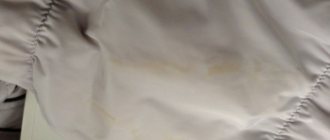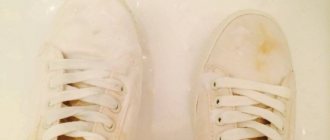One of the most common questions on the Internet regarding laundry concerns the cause of sediment on items that have just been washed. These may be white spots or streaks left on dark items, or blue, green, or yellow residue on light-colored items. Today we will talk about the reasons that cause this problem and how to solve them.
#1: Undissolved laundry detergent
If you use loose laundry detergent, it will not completely dissolve in water. Always pour laundry detergent into the empty dispenser before loading laundry. This will give it more time in the water to dissolve.
If you wash in cold water, especially in very cold climates, the laundry detergent may not dissolve completely. For best results with cold water and laundry detergent, dissolve it first in a container of hot water before adding it to the machine dispenser.
The same steps should be followed with liquid detergent. Never pour detergent directly onto dry clothes or into the washing machine drum; add liquid detergent to an empty dispenser.
If your machine has an automatic dispenser, various detergents may clump in it, since even liquid powders tend to turn into clumps if not dissolved. Remove the dispenser and clean it with hot water mixed with half a cup of distilled white vinegar. If the dispenser does not come off, fill it with pure distilled white vinegar and leave for at least 30 minutes. Then run a wash cycle without any laundry in the drum to empty the dispenser.
This is the most common cause of stains on clothes after washing, so these steps will help solve the problem.
How to prevent white streaks on clothes?
To prevent streaks, the first step before washing is to turn any clothing inside out, regardless of the type of fabric.
If, based on personal experience, you already know which clothes are prone to stains, then use liquid laundry detergent rather than ordinary dry powder.
And for linen of dark or black tones it is better to buy a special gel.
Rinsing after washing should be done by hand, since this is how soap, powder and other products are washed out best. If you prefer automatic rinsing, then you need to do this at least three times.
Clothes that are prone to streaks should be dried horizontally instead of hanging. The bottom line is that numerous smudges that create stains appear precisely because the clothes are hung on ropes, and water flows from them, leaving marks. When drying horizontally, the washed clothes are simply laid out on the clothes dryer.
If you don’t have a dryer, you can spread the laundry on any horizontal surface, for example, on a table. Spread a terry sheet or towel, and then place the washed item on it and carefully straighten it, including the slightest wrinkles. If you dry your laundry on the table, remember that you need to turn it over from time to time so that it dries evenly on both sides.
Inspect the drying clothes - if light stains begin to appear, wash them immediately using the product you wash dishes with. A stain remover applied to white marks and left for a short time will also help remove stains. After this, you need to wash the laundry and rinse it thoroughly, preferably several times.
When washing in an automatic machine, do not fill the tank too tightly with dirty laundry. The fact is that the linen will lack space, things will begin to twist and wrap around each other. It will be difficult to rotate the laundry in the drum; as a result, after such washings, the clothes lose their shape and stretch out. It is due to the large amount of laundry in the drum of the washing machine that light stains appear, since it is physically impossible to get rid of the remnants of powder or other laundry detergent if the laundry is twisted and tangled.
#4: Pumping equipment is clogged or out of flow
If the water flows too slowly during washing and rinsing, undissolved detergent and dirt may remain on your clothes.
Many newer washing machines have a small door on the bottom of the washing machine to access the filter just above the water pump. In older washing machines, you will be able to access the internal parts through the back cover. All this is necessary in order to clean the pump element.
Open your drain system and make sure that the filter is not clogged with dirt, lint or small objects that could obstruct the flow of water and therefore cause streaks on clothes after washing.
Remove powder from colored clothing
Powder is an indispensable assistant in our care for things, but it can also become a little traitor. It can cause stains on freshly washed clothes. How to remove powder stains from colored clothes?
There are several techniques for this. It’s worth starting with the fact that this is necessary immediately, before you just take the item out of the machine. Load the spoiled food back into the drum and rinse again. Then you can do it a second time.
If you washed colored laundry by hand, then you need to place it in a basin of water for some time so that it softens.
Then add shavings of laundry soap and a little vinegar. Rinse thoroughly.
This should help, even if not the first time.
You can also use boiling water, but this method is only suitable for fresh stains. Pour a stream of fresh boiling water over the stain - that's all the advice.
There is another option, but it requires a lot of attention. This stain removal option will require bleach. It must be carefully applied directly along the radius of the stain. The most important thing is to wash it off in time, otherwise you will get another problem. And we will write about it below.
This is interesting: How to clean greasy, glue stains from the floor
Overdone with funds
Exceeding the recommended dose of powder also leads to white-yellow deposits. If there is too much product in the water, it will not be rinsed out and will penetrate deep into the fabric. As a result, foreign residue will remain on things.
When adding detergent to the machine, you must strictly follow the dosage given on the packaging!
Exceeding the norm is especially dangerous when operating high-efficiency washing machines. Such units use less water for washing and rinsing, which makes the process of dissolving the powder more difficult. It is better to underestimate the recommended dosage and regularly clean the dispenser (if it is automatic).
How to properly wash by hand?
Experienced housewives recommend washing lace, silk, chiffon or satin black clothes by hand. Also, delicate hand washing will help preserve the appearance of black cashmere and wool items, and light knitwear.
Algorithm of actions:
- Fill the basin with warm water (temperature no higher than 30C).
- Dissolve liquid laundry detergent for black items in water.
- We immerse the items in the soap solution and leave for ten to fifteen minutes.
- Using gentle squeezing movements (do not actively rub black items), we wash the clothes.
- We rinse things. First add vinegar to the rinse water (a tablespoon per liter of water). Rinsing in vinegar water helps lock in the brightness of black clothing.
It is necessary to rinse black items until clean water begins to drain. Otherwise, there is a high risk of white streaks appearing on black clothes after drying.
Remove on dark stain remover
There is another, no less important problem that needs to be dealt with – stain remover stains. It sounds like a pun, but in reality they are the most difficult to deal with.
First of all, you should take into account the type of stain remover you are purchasing, that is, you should understand them in advance. It is important to remember that no matter what the advertising on TV says, there are no stain removers that can remove absolutely all stains without exception.
These funds are divided into several specially targeted groups - you need to know this. For example, a marker remover will not be able to remove a ketchup stain on black trousers, and a stain remover for delicate fabrics will not cope with severe repair stains on rough work uniforms.
Above all else, the most important thing to remember is timely intervention.
After all, the longer the stain remains on the surface of the clothing, the more difficult it is to remove.
When washing in the washing machine, ensure that the required temperature is maintained.
If, after proper washing, the unpleasant mark still appears on the clothes, resort to a full wash again.
Another important tip that should not be neglected, because it prevents an unpleasant problem from arising, is to test the stain remover on an inconspicuous area of the fabric.
You need to start treating the stain from the edges, otherwise there is a risk that it will spread over a larger area.
Important! After removing the stain with a stain remover, you need to thoroughly rinse the clothes in warm water so as not to encounter a new problem - a stain from the stain remover.
As a last resort, take your clothes to the dry cleaner.
Lemon acid
Unlike vinegar, acid also smells nice, so you don't have to wash the smell out!
How to use:
Dissolve 1 tsp in a glass of hot water. acid and soak a cotton pad in the liquid. Apply to the stain for 10-15 seconds and gently wipe off so as not to damage the fabric. Rinse the area with running water.
Note:
Instead of citric acid, you can take oxalic acid. It’s much less common, but suddenly you just happen to have it lying around.
Photo: big-stirka.ru
Salt and alcohol
A mixture of ammonia and table salt will help remove dirty yellow marks on linen or cotton fabric. Use the composition only on materials of natural origin. This method is also not recommended for delicate items, since large salt crystals can damage the structure of the fibers.
To prepare the composition, you need to take 10 g of salt and 10 ml of ammonia, mix thoroughly and apply to the contaminated area. The item is left alone for 30-40 minutes, then washed with laundry soap for a stronger effect.
Restore fabric using dye
If partial staining of colored items is too noticeable, then the color of the affected items is completely changed. Dyes are used for this purpose. First, the product is dissolved according to the instructions. For more uniform coloring, add table salt.
The matter is either exposed to a hot solution (+40…+60°C) or boiled. Then leave in the liquid for another 20-30 minutes. After this, rinse in water with the addition of acetic acid.
Removing antiperspirant stains
Deodorants and antiperspirants have a negative effect, expressed in stains on black shirts and blouses. How to remove such stains and stripes? To solve the problem, housewives use the following tools that can always be found at home:
- vinegar;
- lemon juice;
- table salt.
A white antiperspirant stain with a characteristic stain can be removed by using vinegar. How to remove such contaminants? To do this, the stained area of clothing is moistened with this product and left for 5-6 hours. After this, you should wash the item as usual in an automatic washing machine.
Another option is table salt. A solution is prepared at the rate of 150 g of salt per 1 liter of water. The item is soaked for 5 hours and then undergoes the main washing process.
White and black laundry with fresh stains can be removed with lemon juice. Apply the product pointwise to the white spots using a swab. 5 minutes after applying the juice, clothes should be washed.
Hydrogen peroxide
Yellowish stains that have appeared recently and occupy a small area of matter can be removed with hydrogen peroxide. You can buy the product at any pharmacy without a prescription. It is not only an antiseptic, but also a high-quality bleach.
In addition to the peroxide itself, you will need a cotton pad and a bar of laundry soap. All traces of a yellow tint should be thoroughly wiped with a cosmetic disc generously soaked in the solution. Then lather and wash. The item should be rinsed under cold running water. If streaks remain, the manipulation must be repeated.
Get rid of after washing
If, after washing, your favorite wardrobe item does not get the desired appearance, and is full of stains from powder, detergent, or whiteness, we recommend resorting to the following, no less original methods.
Method No. 1
If a small, barely noticeable stain appears on your favorite T-shirt, but its very appearance causes negative emotions, inspect the item and evaluate the color. Select a felt-tip pen or marker to match the color of the damaged item and carefully, pointwise, paint over the area affected by bleach. After light “makeup”, iron the affected area through a piece of cloth so that the excess dye is absorbed into it.
This is interesting: Removing tea stains from white or colored clothes
Method No. 2
This method is more suitable for youth T-shirts, which, even at the production stage, are painted with all sorts of colors, deliberately creating stains and streaks.
To carry out this kind of resuscitation efficiently, you will need fabric paint.
In any sewing store you can find all kinds of colors and shades.
Natural fabrics lend themselves best to resuscitation in this way.
Method No. 3
This method is only slightly different from the previous one: to perform it correctly, you will have to go to a fabric store or a nail store and buy acrylic paint in tubes (which is important).
The viscous consistency of this type of paint will allow you to independently draw an applique, a pattern that will cover up, and maybe even organically play up the stain from the cleaning agent.
After the acrylic paint has completely dried on the product, you need to take a piece of cloth, cover the painted area and iron it. Once heated, the acrylic paint will firmly adhere to dense fabric and the pattern you apply yourself will delight you for a long time!
This method is suitable for all types of tissue, but it is best to carry out such resuscitation on rough tissues.
Method No. 4
Suitable for creative people who know how to embroider with thread or ribbons. It’s very beautiful when a bleach stain on a blouse is skillfully hidden under neat embroidery, especially considering that in recent years embroidery has remained quite a fashionable and stylish wardrobe detail. Perhaps a speck of bleach or Domestos will encourage you to create an incredibly fashionable masterpiece?
Method No. 5
This is the easiest and fastest method and is suitable for almost all types of fabrics that can be heated. In order to save your item, you just need to buy a patch at any hardware store. Then, at home, you smooth out the damaged item, put the patch you like on it and iron it thoroughly. Fast and convenient!
Stain remover stick
They are sold anywhere: from underground passages and transport to supermarkets. If you usually pass by, it’s in vain. The product is truly working and versatile!
How to use:
Just use the pencil according to the instructions. Usually you need to rub it on the problem area, wait 10-15 minutes and rinse.
Note:
For white things there are the same bleaches in pencils.
How to clean an iron from burning at home?
How to remove white stains from old deodorant?
It is more difficult to clean a wardrobe item with an old stain of any origin; the contamination is firmly embedded in the fibers of the fabric. Traces on clothing from personal hygiene products in fresh form are difficult to remove; old ones will require the use of complex formulations of various substances. It’s easy to prepare the solutions; we look for the ingredients in the monastery.
In addition to traditional methods, an excellent way out of this situation would be to use a stain remover. When choosing a household chemical store, pay attention to the composition and manufacturer’s recommendations. Not every drug is suitable for black and dark wardrobe items.
How to remove deodorant stains using store-bought products? The process is very simple, the problem area is treated with the purchased product and wait for the time indicated on the package, rinse, and consolidate the results by washing.
Baking soda
Sodium bicarbonate also does a good job of removing stubborn stains that have an unpleasant yellow or brown tint. This is the most affordable remedy, because baking soda can be found in any housewife’s kitchen. To prepare the composition you will need 20-25 g of powder. It is diluted with water to a thick puree and applied to damaged areas. Leave for 1-2 hours, then rinse with cold water.
Preparation and basic washing rules
Before you send clothes made of black fabric for washing, you need to take a number of steps:
Check pockets for forgotten items (napkins, hairpins, coins).- Turn the product inside out (helps maintain color brightness).
- Carefully study the information on the tag. This is the only way to find out the manufacturer’s recommendations regarding the washing mode, water temperature, permission for the ironing process, and spinning.
- Sort dark laundry by fabric type and degree of soiling.
- Old, stubborn stains from black clothing must be removed before the main wash. It is also prohibited to wash clothes made of different types of fabric (for example, wool and silk) and different colors (white and black) at the same time.
Removing stains from multi-colored laundry
Stain removers are suitable for black clothes, but stain removers are not. When choosing a suitable product, pay attention to the composition and properties of the substance. If you are unsure how a product works, try it on a small, inconspicuous area or piece of fabric.
Alcohol
Removing white spots on the armpits from black clothes will help in the fight against alcohol or vodka. What to do:
First, dampen the stain with alcohol.
In most cases, the effect is visible immediately after application. Do not soak the substance on the fabric for more than an hour.
Vinegar
This method is not suitable for white clothes, as the vinegar solution may leave yellowish streaks. Therefore, vinegar should only be used on multi-colored and black clothing:
The vinegar solution is safe for most things. The liquid is safe for sofa upholstery and even woolen sweaters.
Dishwashing liquid
The gel removes fatty protein stains. What to do:










